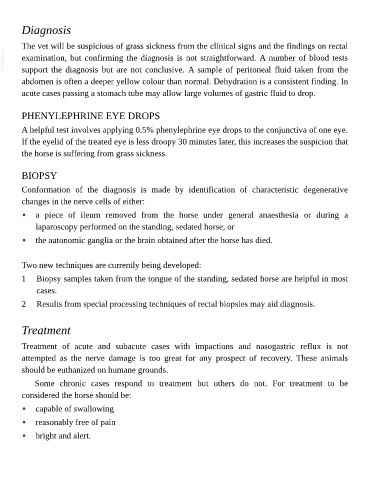Page 509 - The Veterinary Care of the Horse
P. 509
Diagnosis
The vet will be suspicious of grass sickness from the clinical signs and the findings on rectal
VetBooks.ir examination, but confirming the diagnosis is not straightforward. A number of blood tests
support the diagnosis but are not conclusive. A sample of peritoneal fluid taken from the
abdomen is often a deeper yellow colour than normal. Dehydration is a consistent finding. In
acute cases passing a stomach tube may allow large volumes of gastric fluid to drop.
PHENYLEPHRINE EYE DROPS
A helpful test involves applying 0.5% phenylephrine eye drops to the conjunctiva of one eye.
If the eyelid of the treated eye is less droopy 30 minutes later, this increases the suspicion that
the horse is suffering from grass sickness.
BIOPSY
Conformation of the diagnosis is made by identification of characteristic degenerative
changes in the nerve cells of either:
• a piece of ileum removed from the horse under general anaesthesia or during a
laparoscopy performed on the standing, sedated horse, or
• the autonomic ganglia or the brain obtained after the horse has died.
Two new techniques are currently being developed:
1 Biopsy samples taken from the tongue of the standing, sedated horse are helpful in most
cases.
2 Results from special processing techniques of rectal biopsies may aid diagnosis.
Treatment
Treatment of acute and subacute cases with impactions and nasogastric reflux is not
attempted as the nerve damage is too great for any prospect of recovery. These animals
should be euthanized on humane grounds.
Some chronic cases respond to treatment but others do not. For treatment to be
considered the horse should be:
• capable of swallowing
• reasonably free of pain
• bright and alert.

